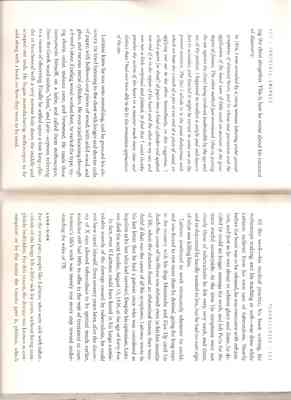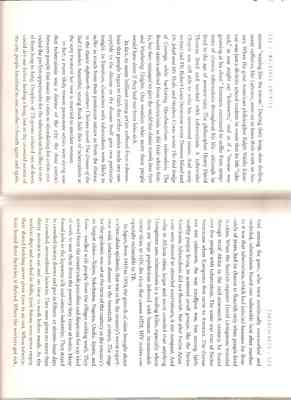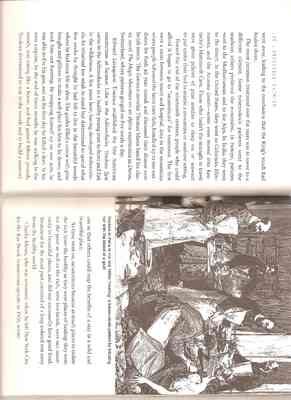Pages
6
ing the chest altogether. This is how he wrote about his moment of discovery. In 1816, I was consulted by a young woman laboring under general symptoms of diseased heart, and in whos case percussion and the application of the hand were of little avail on account of the great degree of fatness. The other method just mentioned [that is, putting the ear against the chest] being rendered inadmissable by the age and sex of the patient, I happened to recollect a simple and well-known fact in acoustics, and fancied it might be turned to some use on the present occasion. The fact I allude to is the great distinctness with which we hear the scratch of a pin at one end of a piece of wood, on applying our ear to the other. Immediately, on this suggestion, I roled a quire [or sheaf] of paper into a kind of cylinder and applied one end of it to the region of the heart and the other to my ear, and was not a little surprised and pleased, to find that I could thereby perceive the action of the heart in a manner much more clear and distinct than I had ever been able to do by the immediate application of the ear. Laennec knew he was onto something, and he pursued his discovery. He tried listening to the chest with longer and shorter coils of paper, with hollowed-out pieces of wood, with solid wood, and glass, and various metal cylinders. He even tried listening through a friend's oboe. Finding wood worked best, he varied the type, trying ebony, cedar, malacca cane, and limewood. He made these instruments himself, on a lathe, and called them stethoscopes, from the Greek word stethos, "chest", and latin -scopium, referring to a means of observing. Finally he settled upon a foot-long cylinder of beechwood with a very narrow hole down the middle and scooped-out ends. He began manufacturing stethoscopes to be sold along with a book on how they were to be used. All this work - his medical practice, his book writing, his stethoscope making, and his teaching as well - was done while Laennec suffered from his own case of tuberculosis. Shortly before the book was to be released, he was overcome with exhaustion, and just as he was about to acheive glory and fame, he decided he could no longer manage his work, and left Paris for the more restful countryside. At the time his symptoms were not clearly those of tuberculosis: he felt very, very weak, and dizzy, and so depressed he hardly wanted to live, but he had no sure sign of what was killing him. Laennec continued to work strenuously whenever he could, and was forced to rest more than he desired, going for long stays in the country with his dogs Moustache and Kiss. Up until his death the cause of his illness was debated: even in his last months of life, when the doctors found an abdominal tumor, they wondered if that was the cause of all his symptoms. Laennec wrote in his last letter that he had a patient once who was considered as hopeless as he but who had survived. Despite his optimism, Laennec died the next Sunday, August 13, 1826, at the age of forty-five. In fact, even if Laennec could have heard in his lungs unmistakable sounds of the damage caused by tuberculosis, he could not have cured himself. Even seventy years later, after the discovery of X rays allowed tuberculosis to be spotted much earlier, medicine still had little to offer in the way of treatment or cure. Laennec's life's work was merely one more step toward understanding the wiles of TB. Luke-Sick For the most part, people like Laennec who were sick with tuberculosis of the lungs felt a little sick for years, without being completely bedridden. For this reason, the disease was known as consumption or by the name the Greeks gave it, phthisis, which
7
means "waning like the moon." During their long, slow decline many sufferers, like Laennec, went on to leave their mark on history. When the great American philosopher Ralph Waldo Emerson was just a divinity school student he wrote that he felt "luke-sick", as one might say "lukewarm", and as if a "mouse was gnawing at his chest." Emerson continued to suffer from symptoms of chronic tuberculosis throughout his life - although he lived to the age of seventy-nine. The philosopher Henry David Thoreau lived and worked with tuberculosis. A tubercular Chopin was still able to write his renowned music. And many writers had TB: Robert Louis Stevenson wrote Treasure Island and Dr. Jekyll and Mr Hyde, and Stephen Crane wrote The Red Badge of Courage, while harboring Mycobacterium Tuberculosis. The Bronte sisters suffered from tuberculosis, as did their whole family, but the managed to give the world the classic novels Jane Eyre and Wuthering Heights. One wonders what more these people would have done if they had not been luke-sick. In fact, so many brilliant young artists suffered from tuberculosis that people began to think that either genius made on susceptible to the disease or the disease itself gave one particular insight. In literature, characters with tuberculosis were likely to suffer as much from their passionate nature as from the disease. In the classic eighteenth-century Chinese novel The Dream of the Red Chamber, beautiful, young Black Jade dies of tuberculosis at the very moment her love is married to another woman. In fact, a more likely reason passionate artists were dying was that tuberculosis was a disease of the city: the close contact between people that made the cities so stimulating for artists provided the perfect opportunity for the tuberculosis bacillus to travel from lung to lung. Droplets of TB germs exhaled out of doors could dry out before finding a lung, but in the crowded rooms of the city, people breathed in one another's breath again and again. And among the poor, who were contnually overworked and underfed, tuberculosis found one vulnerable host after another. So it was that tuberculosis, which had infected humans for thousands of years, had its change to flourish only when people lived in cities. When the Scottish explorer David Livingstone traveled through rural Africa in the mid-nineteenth century, he found very few people with tuberculosis. The same was true of Native Americans when Europeans first came to America. The disease was not unknown, the way smallpox was, but among fairly healthy people living in scattered small groups, like the Native Americans, tuberculosis did not flourish. But after Native Americans were moved to crowded reservations, it ran rampant. And today in African cities, larger and more crowded than anything Livingstone saw, tuberculosis is a leading killer, especially where there are large populations infected with human immunodeficiency virus, or HIV, the virus that causes AIDs. HIV makes one especially vulnerable to TB. In Japan, from 1910 to 1950, the growth of cities brought about a tuberculosis epidemic that was to be the country's worst experience with infectious disease in the twentieth century. The stage of the epidemic was set at the turn of the century as the country's six largest cities - Tokyo, Yokohama, Nagoya, Osaka, Kyoto, and Kobe - swelled with people from the villages seeking work. They arrived from the countryside penniless and desperate for any kind of work to save them from the poverty they knew at home. Mnay found jobs in the Japanese silk and cotton industries. They stayed in crowded factory dorms an put in fifteen- or sixteen-hour days in crowded, unventialted factories. they were given no more than thirty minutes to eat and no time to wash before meals. As the workers slept and worked in shifts, their futons were never empty, their shared bedding never given time to air out. When tuberculosis found these factories, it thrived. When workers got sick,
8
as so many did, they were sent home. And when they returned to their villages, they spread the disease to their families. The textile factories' reputation became so bad even people desparate for a job refused to work there. The factories were forced to send recruiters to more and more remote cities, and this helped spread the disease far and wide, A great epidemic began. Between 1910 and 1950 six million people were to die of tuberculoiss in Japan, at a time when the country's population ranged from 50 to 93 million. By the end of these years, hardly a family in the entire nation was not touched by this disease. SEAWEED, SAXOPHONES, AND MAGIC MOUNTAINS For the six thousand years that we know peopl have had tuberculosis, its has been only during the past fifty that medical science could help them at all. However, even with no treatment, sometimes people got better on their own. This meant that over the years that they were ill, people might try something, such as Laennec's seaweed treatmetn, and sometimes would happen to get better. But it was difficult to tell with a slow-moving disease whether a treatment really helped or only seemed to help. Over the thousands of years of the history off tuberculosis, thousands of things have seemed to work. For a bloody cough, people have taken sulfur, garlic, quince, endive, cabbage, and burnt lungs of vulture mixed with lily blossoms and wine. For a cough, they have tried the herbs horehound and dill, boiled crocodile, and a lukewarm bath in urine taken from persons who had just eaten cabbage. Tuberculosis sufferers have ingested quinine, tea, coffee, cocoa, tobacco, cod-liver oil, and opium. They have been bled, blistered, and made to vomit. They have rubbed human fat on their tubercular necks. People have ingested twelve eggs a day, lobster, milk from highland goats, milk from asses, and milk from humans. They have been force-fed, and they have been starved. Some patients have been ordered to lie flat and still, forbidden even to so much as talk or laugh; others have been told to ride horseback six hours a day, to ski, to spin in revolving chairs until they were nauseous. Adolphe Sax, who invented the saxophone, claimed that playing the instruments staved off consumption. Others swore swinging on a swing was the answer. Kings and queens of France and England from the Middle Ages until the early nineteenth century laid their hands on people suffering from tuberculosis of the lymph nodes and were said to heal them. This type of tuberculosis infection, known as scrofula, causes the neck to swell in two great bulges below the corners of the jaw, and then open in foul-smelling sores. Left untreated, the disease could spread onto the face. Though not fatal, it was horribly disfiguring, and people would travel on foot from the farthest corners of the kingdom to be touched by the King. Sometimes, on their weeks- or months-long journey back home, the scrofula.
9
went away, leading to the conclusion that the King's touch had healed them. The most common treatment over the years was to move to a different climate. Some tuberculosis patients went to the seashore; others preferred the mountains. In Europe, patients went to the Mediterranean and to the Alps. In India, they went to the desert. In the United States, they went to Colorado, Minnesota, and the Arizona desert - some even moved into Kentucky's Mammoth Cave. Those who hadn't the strength to travel were given pillows of pine needles to sleep on or seaweed to put under their bed to mimic a mountain or seashore setting. Toward the end of the nineteenth century, people who could afford it began to go to "sanatoriums" for treatment. The first were a cross between resort and hospital, inns in the mountains where people followed the latest cure fads, bundled up to rest outdoors for fresh air year round, and discussed their disease over lavish meals. The German novelist Thomas Mann based his classic novel The Magic Mountain on an alpine sanatorium in Davos, Switzerland, where patients gorged on five meals a day. Edward Livingston Trudeau established the first American sanatorium at Saranac Lake in the Adirondacks. Trudeau first came to the Adirondacks as a healthy young man to hunt and fish in the wilderness. A few years later having developed tuberculosis, he returned too weak to stand but determined to spend what few weeks he thought he had left to live in the beautiful woods where he had once felt so alive. The guides filled a canoe with pine boughs and pillows to make a soft place for him to lie down, and took him out hunting. By propping himself up on one arm, he was able to fire his gun, and on his first day he killed a deer. To his own surprise, by the end of three months he was walking in the woods, was eating like a horse, and had gained fifteen pounds. Trudeau determined to stay in th woods and to build a sanatiorium so that others could reap the benefits of a stay in the wild and beautiful place. As time went on, sanatoriums became as much places to isolate the sick from the healthy as they were places of healing: they were for the poor as well as the rich, were less lavish, were not necessarily in beautiful places, and did not necessarily have good food. Treatment for the most part consisited of a long isolated rest away from the healthy world. Charles Moses, who was seventeen when he left New York City for the Ray Brook Sanatorium upstate in 1920, wrote:
10
I spent probably the happiest eleven months of my life in that sanatorium. It was a place which opened my eyes to the world... My parents didn't come up for eleven months. Nobody, nobody came up because it was supposed to have been a secret. In those days, tuberculosis was a disease which you were supposed to conceal. It was almost like a venereal disease is now. And when my mother used to send me "care" packages of food and gifts and she would meet one of her sisters living in the area and they would see her, they would ask, "Where are you taking this?" "I am taking this to Charlie", she would say. "He is in college." Cast out of the world of the healthy, tuberculosis patients created a world of their own in the sanatoriums. One young American patient, Betty MacDonald, who was a thirty-year-old working single mother of two girls when she found out she tuberculosis, describes entering the sanatorium world: Getting tuberculosis in the middle of your life is like starting down-town to do a lot of urgent errands and being hit by a bus. When you regain consciousness, you remember nothing about the urgent errands. You can't even remember where you were going. The important things now are the pain in your leg; the soreness in your back; what will you have for dinner; who is in the next bed. Patients could spend five, ten, even twenty years in a numbing routine of bed rest and meals. When first admitted to the sanatorium she calls "The Pines" in 1938, MacDonald had to spend every day lying down: that meant no reading, no talking, no laughing, no reaching too far out of bed to get things. Betty was informed sternly that her red hair would be a liability, as a red-head was likely to be viviacious and thus have difficulty lying still and solemn. Not lying still, she was told, would lead to death. Things did get better: after three months at the Pines, if you showed improvement, you could go outside on the sleeping porch and lie still, bundled in blankets against the cold. MacDonald began to think that life in the sanatorium would "make dying seem like a lot of fun." Because patients lived in sanatoriums, sharing their rooms with total strangers, for months and years of their lives, the sanatorium world brought out the prejudice in people, and separate hospitals wre built for blacks and Native Americans to stay. Although it might have been hard for Betty MacDonald to imagine a worse place to spend the first years of her thirties, a young Lakota woman, Madonna Swan, wrote of a sanatorium stay that was even more dreadful and nearly deadly. Madonna Swan was just sixteen when she found she had tuberculosis. She had seen four schoomates suddenly begin to cough blood and rapidly die from the disease. She knew all too well where the chest pains and cough that she shared with them would lead, but Madonna was sent to the doctor before it was too late, and he sent her to the "Sioux San." That was in 1944. During the first two years Madonna Swan spent at the Sioux San, no patient left alive - no one even went out on leave: the only patients to leave were the dead. The patients were all dressed in striped uniforms, like prisoners. Meals were beans and cornmeal spotted with mouse droppings. The healthier patients spent the morning bathing the sicker ones, and they all spent the afternoons from one to five lying on their beds with bean bags on their chests. Madonna's treatment consisted of four pounds of bean bags on the chest and one cup of cod-liver oil to drink daily. The bean bags were supposed to compress the lungs and suffocate the germs. After six years of this treatment, to doctor




